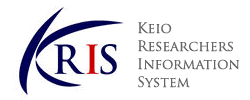-
Affiliation
-
Faculty of Science and Technology (Mita)
-
Position
-
Professor Emeritus

KEIO RESEARCHERS INFORMATION SYSTEM |
Details of a Researcher
このページはJavascriptを使用しています。すべての機能を使用するためにはJavascript を有効にする必要があります。
Minami, Mihoko
|
|
|
Japan Univac Co.Ltd.
Science University of Tokyo, Faculty of Science, Department of Applied Mathematics, Assistant Professor
The Institute of Statistical Mathematics, Department of Mathematical Analysis and Statistical Inference, Associate Professor
The Graduate University for Advanced Studies, School of Multidisciplinary Sciences, Department of Statistical Science, Associate Professor
Keiou University, Faculty of Science and Technology, Part-time Lecturer
Ochanomizu University, Faculty of Science, Department of Mathematics
University, Graduated
University of California, San Diego Master course, Department of Mathematics
United States, University, Graduated
University of California, San Diego Department of Mathematics, Ph.D. course, Department of Mathematics
United States, University, Graduated
Ph.D., University of California, San Diego, Coursework, 1993.12
Informatics / Statistical science (Statistical Science)
環境リスク解析,
Cyclic regression smoothing spline for environmental data,
Regression and Classification problem for distributions,
Feature extraction method from very non-normal data,
生物資源評価,
統計科学百科事典
MINAMI Mihoko, 丸善出版, 2018.12
Scope: マルチレベル解析など12項目
新版医学統計学ハンドブック
丹後俊郎 ・松井茂之 編, 朝倉書店, 2018.07
Scope: 6章 線形回帰モデル
岩波データサイエンス Vol.3 特集:因果推論――実世界のデータから因果を読む
Tomoshige Nakamura, Mihoko Minami, 岩波書店, 2016.06
Scope: 傾向スコアを用いたバント効果の推定 ノーアウト1塁のバントは,得点確率を有意に高めるか!?
医学統計学の事典
MINAMI Mihoko, 朝倉書店, 2010.06
Scope: 270-271
Cleridy E Lennert-Cody, Cristina De La Cadena, Luis Chompoy, Mark N Maunder, Daniel W Fuller, Ernesto Altamirano Nieto, Mihoko Minami, Alexandre Aires-da-Silva
Fishes (MDPI) 10 ( 10 ) 494 2025.10
Research paper (scientific journal), Accepted
Peripubertal lung growth pattern in Japanese school children
Konno S., Taguri M., Odajima H., Minami M., Takebayashi T., Nitta H., Nishimura M.
Physiological Reports 13 ( 16 ) 2025.08
Michikawa T., Nishiwaki Y., Asakura K., Okamura T., Takebayashi T., Hasegawa S., Milojevic A., Minami M., Taguri M., Takeuchi A., Ueda K., Sairenchi T., Yamagishi K., Iso H., Irie F., Nitta H.
Journal of Atherosclerosis and Thrombosis 32 ( 8 ) 982 - 993 2025
ISSN 13403478
Shintaro Yoneyama, Mihoko Minami
International Journal of Statistics and Probability (Canadian Center of Science and Education) 13 ( 4 ) 26 - 41 2024.11
Research paper (scientific journal), Joint Work, Last author, Accepted, ISSN 1927-7040
Mihoko Minami and Cleridy E. Lennert-Cody
Journal of Agricultural, Biological and Environmental Statistics 2024.06
Research paper (scientific journal), Joint Work, Lead author, Last author, Corresponding author, Accepted, ISSN 10857117
Statistical modelling and methods for environmental risk analysis and biological resource assessment
Minami, Mihoko
科学研究費補助金研究成果報告書 2022
Minami, Mihoko
科学研究費補助金研究成果報告書 2013
New challenges for statistics education for lifelong learning in the knowledge-based society
Minami, Mihoko
科学研究費補助金研究成果報告書 2013
Model for Bycatch and Clustering Method for Distributions
Mihoko Minami
[International presentation] International Day of Women in Statistics and Data Science,
Oral presentation (invited, special), CAUCUS FOR WOMEN IN STATISITCS AND DATA SCIENCE
Bayesian Clustering for Distributions
Mihoko MInami, Cleridy E. Lennert-Cody
[International presentation] Joint Statistical Meetings 2024 (Portland ) ,
Oral presentation (general), American Statistical Association
Bayesian Clustering for Distributions
Mihoko Minami
[International presentation] RIMS Symposium: Statistical Learning Methods for Dynamical Modeling and Applications,
Oral presentation (general)
分布のクラスタリングによる空間の分割とクラスターの均一性の検定
Mihoko MInami, Cleridy E. Lennert-Cody
[Domestic presentation] Annual Meeting of Japanese Society of Applied Statistics (Fukuoka ) ,
Oral presentation (general), Japanese Society of Applied Statistics
Mihoko MInami, Cleridy E. Lennert-Cody
[International presentation] BOSTON-KEIO-TSINGHUA WORKSHOP 2023 (Boston ) ,
Oral presentation (general), Boston University, Keio University, Tsinghua University
分布データの解析手法,統計的推測法の提案と生物資源評価,生態・環境データへの応用
MEXT,JSPS, Grant-in-Aid for Scientific Research, Grant-in-Aid for Scientific Research (C), Principal investigator
環境リスク解析・生物資源評価のための統計的モデリングと解析手法
独立行政法人 日本学術振興会, Grant-in-Aid for Scientific Research, Research grant, Principal investigator
Jacob Wolfowitz prize
Mihoko Minami and Kunio Shimizu, 2001.12, American Journal of Mathematical and Management Sciences, ML and REML estimation of Matusita's measure for two bivariate normal distributions with missing observations
TOPICS IN STATISTICAL SCIENCES A
2024
TOPICS IN LIFE INSURANCE MATHEMATICS
2024
STATISTICAL SCIENCE AND ITS EXERCISE
2024
SEMINAR IN STATISTICAL SCIENCES
2024
INTRODUCTION TO STATISTICAL SCIENCE
2024
データサイエンス特別講義
慶應義塾大学理工学研究科
Autumn Semester
数理統計学第二
慶應義塾大学理工学部
Autumn Semester
数学2B
慶應義塾大学理工学部
Autumn Semester
統計輪講
Keio University
Autumn Semester, Within own faculty, 1h
データ解析同演習
Keio University
Autumn Semester, Seminar, Within own faculty, 1h
微小粒子状物質等疫学調査研究検討会 環境省 水・大気環境局
AISM 編集委員会
国際計量生物学会 IBC2012 実行委員会,
国際計量生物学会 IBC2010 国際プログラム委員会,
2004年度統計関連学会連合大会 事務局,
2003年度統計関連学会連合大会 事務局,
Fourth International Sysmposium on Independent Component Analysis and blind source Separation (ICA2003),
Director, Japanese Society of Applied Statistics
Director, Japanese Federation of Statistical Science Associations
Coordinating Editor, Japanese Journal of Statistics and Data Science
Chair, Special Committee for the Promotion of Diversity, Japan Statistical Society
委員長, 日本統計学会学会活動特別委員会